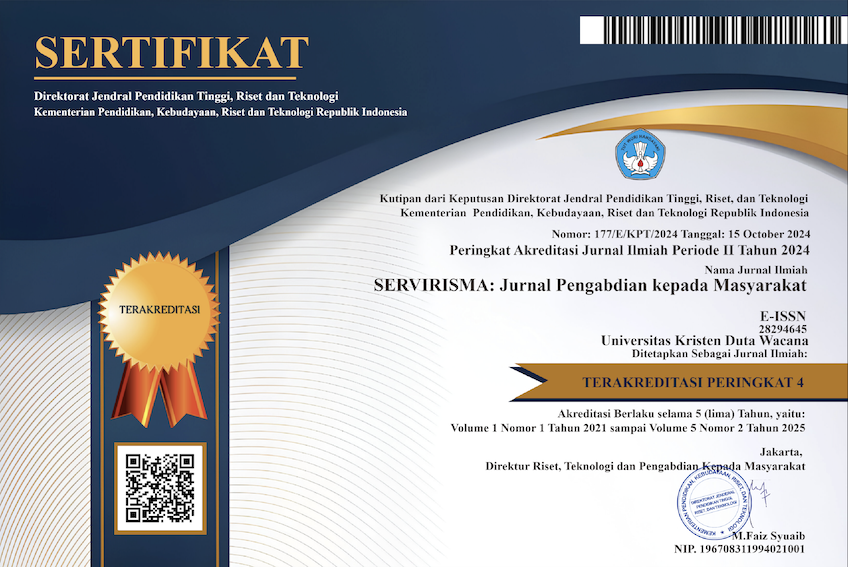TEACHING AND PRACTICING OF PREBIOTIC POTENTIAL TEST OF LOCAL FUNCTIONAL FOOD AT 7 STATE SENIOR HIGH SCHOOL
DOI:
https://doi.org/10.21460/servirisma.2023.32.59Keywords:
banana corm, cookies, functional food, prebiotikAbstract
Application of Biotechnology in Indonesia has been found in many sectors especially in food sector. One of the benefits is that it can be used to increase the nutritional value of food product so that it can be beneficial for health and decrease the risk of disease. The introduction of Biotechnology in utilizing local food product will increase students’ sensitivity about natural materials and their utilization. The purpose of this program was to introduce the role of Biotechnology in utilizing and processing agriculture by-product into beneficial edible end-product. This activity was divided into three stages: preparation, implementation, and reporting the activity. Preparation was done by contacting 7 State Senior High School as a partner. Implementation was conducted in partner’s Laboratory of Biology by delivering the teaching materials, continued with producing banana corm cookies and checked its prebiotik capability. Banana corm cookies were successfully produced. In vitro study showed that Lactobacillus plantarum FNCC-0265 were able to grow in banana corm cookies substituted media. The students showed a positive response during the activity, and it was shown by creation of the cookies and their ability to use drop plate technique for bacterial enumeration in vitro.
References
Al-Sheraji, S. H., Ismail, A., Manap, M. Y., Mustafa, S., Yusof, R. M., & Hassan, F. A. (2013). Prebiotiks as functional foods: A review. Journal of Functional Foods, 5(4), 1542–1553. https://doi.org/10.1016/j.jff.2013.08.009
Anadón, A., Martínez-Larrañaga, M. R., Arés, I., & Martínez, M. A. (2016). Prebiotiks and Probiotics. Probiotics, Prebiotiks, and Synbiotics, 3–23. https://doi.org/10.1016/B978-0-12-802189- 7.00001-0
Ariestanti, C. A., Seechamnanturakit, V., Harmayani, E., & Wichienchot, S. (2019). Optimization on production of konjac oligo-glucomannan and their effect on the gut microbiota. Food Science & Nutrition, September 2018, 1–9. https://doi.org/10.1002/fsn3.927
Bansele, M., Sabtu, B., & Riwu, A. R. (2022). Substitusi Tapioka dengan Tepung Bonggol Pisang Kepok terhadap Kualitas Kimia dan Organoleptik Sosis Ayam Kampung. Jurnal Peternakan Lahan Kering, 4(3), 2269–2277.
Davani-Davari, D., Negahdaripour, M., Karimzadeh, I., Seifan, M., Mohkam, M., Masoumi, S. J., Berenjian, A., & Ghasemi, Y. (2019). Prebiotiks: Definition, types, sources, mechanisms, and clinical applications. Foods, 8(3), 1–27. https://doi.org/10.3390/foods8030092
Hasler, C. M. (2002). Functional foods: benefits, concerns and challenges-a position paper from the american council on science and health. The Journal of Nutrition, 132(12), 3772–3781. https://doi.org/10.1002/mus.20330
Isolauri, E., & Ouwehand, A. C. (2004). Probiotics. Best Practice & Research Clinical Gastroenterology, 18(2), 299–313. https://doi.org/10.1053/ybega.2004.443
Keservani, R. K., Kesharwani, R. K., Vyas, N., Jain, S., Raghuvanshi, R., & Sharma, A. K. (2010). Nutraceutical and Functional Food As Future Food: A Review. Der Pharmacia Lettre, 2(1), 106–116.
Rajoka, M. S. R., Thirumdas, R., Mehwish, H. M., Umair, M., Khurshid, M., Hayat, H. F., Phimolsiripol, Y., Pallarés, N., Martí-Quijal, F. J., & Barba, F. J. (2021). Role of food antioxidants in modulating gut microbial communities: Novel understandings in intestinal oxidative stress damage and their impact on host health. In Antioxidants (Vol. 10, Issue 10). MDPI. https://doi.org/10.3390/antiox10101563
Rakhmawati, R. (2019). Pemanfaatan Bonggol Pisang Menjadi Stick Nugget Untuk Peningkatan Gizi Masyarakat Desa Soket Laok Tragah Kabupaten Bangkalan. Jurnal Ilmiah Pangabdhi, 5(1). https://doi.org/10.21107/pangabdhi.v5i1.5165
Rastall, R. A., & Gibson, G. R. (2015). Recent developments in prebiotiks to selectively impact beneficial microbes and promote intestinal health. Current Opinion in Biotechnology, 32, 42– 46. https://doi.org/10.1016/j.copbio.2014.11.002
Saputra, M. W. L., Ariani, R. P., & Damiati. (2019). Pemanfaatan Tepung Bonggol Pisang Kepok (Musa acuminata Balbisiana) Menjadi Choco Cookies. Jurnal Bosaparis, 10(3), 195–204. www.resepkoki.id,
Saragih, B., & Dollu, K. (2018). Pemanfaatan Tepung Bonggol Pisang (Musa paradisiaca Linn) Sebagai Pangan Alternatif dalam Mendukung Ketahanan Pangan.
Wenas, D. M. (2017). Kajian Ulasan Aktivitas Farmakologi dari Limbah Pisang Ambon dan Pisang Kepok. Sainstech Farma, 10(1), 30–36.
Downloads
Published
How to Cite
Issue
Section
License
Copyright (c) 2023 Catarina Ariestanti

This work is licensed under a Creative Commons Attribution-NonCommercial-NoDerivatives 4.0 International License.
Authors who publish articles in SERVIRISMA agree on the following rules:
1. The author grants non exclusive royalty free rights, and is willing to publish articles online and complete (full access). With such rights SERVIRISMA reserves the right to save, transfers, manages in various forms, maintains and publishes articles while keeping the author's name as the copyright owner.
2. Each author contained in the article has contributed fully to the substance and intellectual, and is accountable to the public. If in the future there is a copyright infringement notification then this will be responsibility of the author, not SERVIRISMA .









